

Autumn Speyside Whisky Festival Report and Tour in the Highlands, September 27th-October 04th, 2009
Day 5:
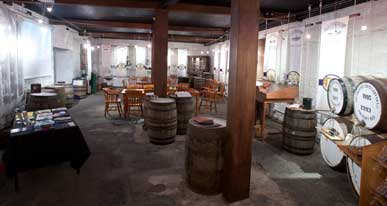 |
| The visitor center at Old Pulteney. |
After a 2 h drive to Wick, I arrived on time for the 11 am tour at Old Pulteney distillery. The visitor center was well made up and I was guided through the distillery by the prettiest Guide I had ever had Unfortunately, she was unable to answer most of my technical question. Answers were satisfactorily given after the tour. At the Old Pulteney distillery, they work rather unusual shifts, with 12 days of production followed by 2 days of rest. The shape of the stills are unusual, the lyne arm particularly twisted, and Old Pulteney is one of the rare distilleries to use dry yeast. In addition, copper worm tubes are still in use.
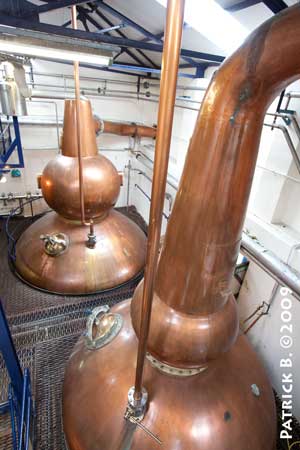 |
| The still house of Old Pulteney. |
After this visit, I move to the sister distillery of Balblair for taking some photographs. Since my last visit about 3 years ago, the new "B" of Balblair can be seen everywhere, as well as explicative signs in all sections of the distillery.
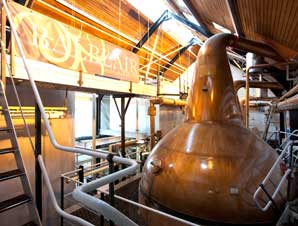 |
| The still house of Balblair. |
A new "draft" visitors’ center has been built by the distillery staff in the old floor maltings. It is nicely done, but the decision whether to open it or not is based on a feasibility report.With all the efforts done by the staff, I hope that the outcome will be positive. Since 2006, Balblair is one of the few distilleries not only to pre-heat the wash still, but also the still house, allowing an appreciable gain in energy without affecting the flavours of the end product. Of note, Balblair is now maturing some spirit with casks coming from the mother house (Thai Beverage) in Thailand.
On my way down South, I made a short break at Glenmorangie to see the new still house in operation. Glenmorangie is currently working 7 days a week, and with the extended still house, the capacity of production is now of 6 mio LPA, a volume which should compensate the volume of production of Glen Moray, sold about 1 year ago to La Martiniquaise.
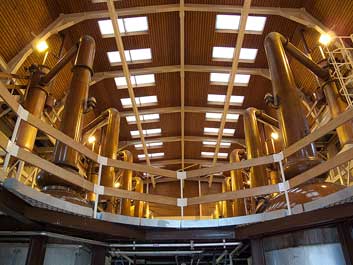 |
| The extanded Still house at Glenmorangie. |
Day 6:
 |
| The Old Harbour of Portsoy |
After a nice stay at the fishing village of Portsoy, I went to my appointment with Graham Eunson at the Glenglassaugh distillery. The distillery is an image of contrast, with a mixture of modern concrete buildings and old original stone buildings. During my visit, I learnt that Highland Distillers, the previous owners, installed a water softening plant at the distillery in order to produce a light "speyside" whisky. This did not prevent the distillery to be mothballed once the extension work at Glenrothes was completed. The history of Glenglassaugh is very interesting and Ian Buxton is currently writing a book about it. His work should be completed by the end of this year.
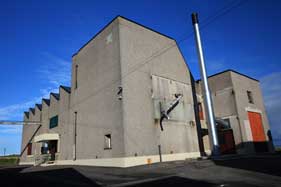 |
| The Glenglassaugh distillery. |
The new owner will use the hard water of the source without any softening and they have slightly changed the process in order to create a heavier Highland style of whisky. Over £1mio has been spent on the distillery before the re-opening, including the installation of the new gas boiler, which made it necessary to make a hole in the wall in order to remove the old one. I was also informed that the plates of the mash tun had been stolen in 2007 and that the thieves had drilled holes in the stills and on the copper lid of the mash tun to take the copper out. Fortunately, these theives were arrested while operating at the Imperial distillery; otherwise Glenglassaugh might have experienced the same fate as Rosebank.
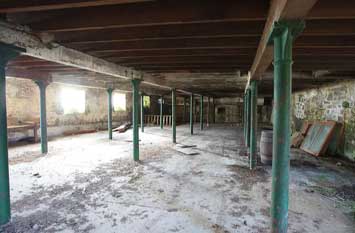 |
| The old malting floor at Glenglassaugh. |
Another interesting feature of the distillery was its operational process. The spirit sill (17,000 L) was larger than the wash still (12,000 L), which was more than 2 times smaller than single washback (26,000 L). This means that under the previous ownership, a wash was charged more than twice and that the volume inside the wash still was each time different leading to a different spirit at each distillation. Speak about consistency. To resolve this issue, the new owner switched the spirit and the wash stills. The fermentation takes between 62 and 84 hours and only the wooden washbacks are used (they have 2 additional stainless steel washback). Although the capacity of production is 1mio LPA, only 200,000 LPA are produced. As part of their deal, the new owners managed to acquire 500 casks dating from 1963 to 1996.
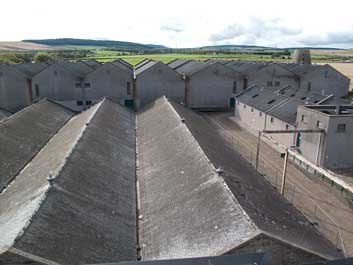 |
| The warehouses at Glenglassaugh: enough space for expansion. |
Since the first mash on November 24, 2008, 1000 casks have been filled and Glenglassaugh is offering a Cask buyer's scheme (for more details, www.glenglassaugh.com).
After the tour, I was offered a taste of the new batch of Glenglassaugh 30 YO which has just been bottled. Probably from a refill cask, this 30 YO (in fact 37 YO) whisky was excellent, rich, intense and complex, with a surprising vitality. It was bottled at cask strength (43.0%). The Glenglassaugh 40 YO was a different whisky, darker in colour, with a stronger sherry influence and more tannins. A very good whisky, which should appeal to the lovers of old sherry-matured whiskies. All Glenglassaugh are manually bottled on site. In addition, at the request of whisky aficionados, the 30 YO might be bottled in the same decanter as the 21 YO, which would positively impact on the price. This would be a good move, since I am not very fond of these large "bulky" crystal decanters.
After this enjoyable morning, I moved on to Inchgower for taking some outdoor photographs, since visits were not possible and finally drove to GlenDronach,
At GlendDonach, the new visitors’ center had been flooded, just when it was ready to be opened. Don't worry, the shop is still open and tours conducted. Since they placed signs on the A96 road from Aberdeen to Inverness, the number of visitors have doubled. Before that, finding its way to the distillery was not always easy. Under the new ownership, the changes are not striking, but a lot of work has been done behind and the distillery resumed production only very recently. The negotiations between Chivas and the BenRiach company Ltd should not have been easy, since Billy Walker and his team had to trade some old BenRiach casks to get some old GlenDronach casks.
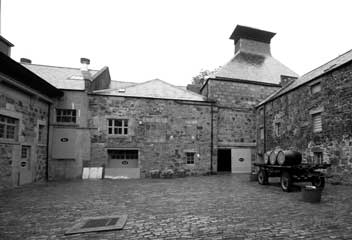 |
| Inside the courtyard of GlenDronach distillery. |
I was kindly guided through the distillery by Stewart Buchanan, the distillery manager of BenRiach. I took the opportunity to ask him a few questions about BenRiach distillery (of note, Stewart and Allan are currently alternating between BenRiach and Glendronach). At BenRiach, they have serious intention of re-opening the malting floors, although the capacity of the malting floors would not exceed 5% of their total production and they are producing 50,000 LPA of triple-distilled BenRiach. Additionally, all the production of heavily peated BenRiach is kept within the company, while some amounts of non-peated BenRiach are sold to third parties such as Chivas.
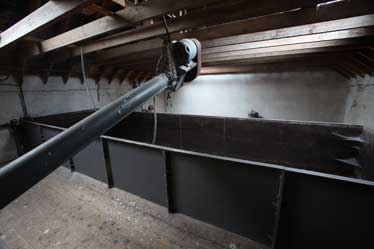 |
| The old steeping tank at GlenDronach |
To come back to GlenDronach, the floor malting operations were stopped in 1996 (?) and will not be resumed, since the investment would be too heavy (the malt loft would need serious reparations). One interesting particularity in GlenDronach, in addition of a old cast iron mash tun, is the use of pans for heating the wash stills. The most observable change is in the warehouses, in particular in the filling store, where an impressive display of sherry and Pedro Ximenez cask were waiting for filling. In addition, a massive operation of re-reacking bourbon casks into sherry cask is ongoing. The financial investment is massive, but I am glad to see that Billy Walker took this initiave and I am convinced it was the right move. I am personally very fond of sherry cask matured GlenDronach.
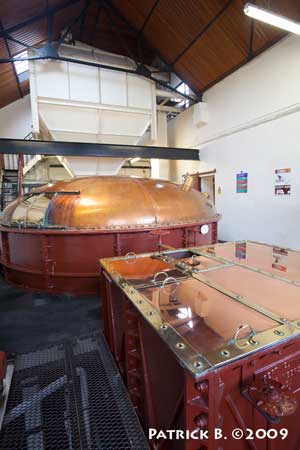 |
| The mash tun house of GlenDronach. |
In addition of sherry casks, some spirits are filled into Sauternes and Port casks, as well as in some quarter casks. I could taste some GlenDronach finished for 1 year in a Sauternes cask before being re-racked into a sherry cask: the Sauternes influence was discreet, but brought in some pleasant additional sweet-sugary notes. Then we sampled a Bourbon cask from the early 1990s, with some beautiful and fresh fruity notes, with plenty of apricots and other sweet fruits, somewhat resembling the old BenRiach 1976. One of the most noticeable changes I observed during my stay at the GlenDronach distillery is the motivation of the staff. Billy has plenty of new ideas and this stimulates the whole team. GlenDronach needed such an input and I am sure we will hear a lot from this distillery in the future.
Patrick B. © 25 Oct 09